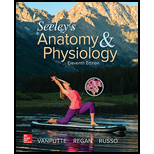
Seeley's Anatomy & Physiology
11th Edition
ISBN: 9780077736224
Author: Cinnamon VanPutte, Jennifer Regan, Andrew F. Russo Dr., Rod R. Seeley Dr.
Publisher: McGraw-Hill Education
expand_more
expand_more
format_list_bulleted
Concept explainers
Question
Chapter 19.2, Problem 5AYP
Summary Introduction
To analyze:
The major components of blood.
Introduction:
The cardiovascular system is made of different components. The heart constitutes the primary organs of the system, and the arteries, veins, and blood capillaries form the associated structures of the cardiovascular system.
Expert Solution & Answer
Want to see the full answer?
Check out a sample textbook solution
Students have asked these similar questions
The Sentinel Cell: Nature’s Answer to Cancer?
Molecular Biology Question
You are working to characterize a novel protein in mice. Analysis shows that high levels of the primary transcript that codes for this protein are found in tissue from the brain, muscle, liver, and pancreas. However, an antibody that recognizes the C-terminal portion of the protein indicates that the protein is present in brain, muscle, and liver, but not in the pancreas. What is the most likely explanation for this result?
Molecular Biology
Explain/discuss how “slow stop” and “quick/fast stop” mutants wereused to identify different protein involved in DNA replication in E. coli.
Chapter 19 Solutions
Seeley's Anatomy & Physiology
Ch. 19.1 - List the ways that blood helps maintain...Ch. 19.1 - Prob. 2AYPCh. 19.1 - What is the normal pH range of the blood?Ch. 19.1 - Prob. 4AYPCh. 19.2 - Prob. 5AYPCh. 19.2 - Prob. 6AYPCh. 19.3 - Prob. 7AYPCh. 19.3 - Prob. 8AYPCh. 19.3 - Explain how plasma volume remains relatively...Ch. 19.4 - Name the three general types of formed elements in...
Ch. 19.4 - Prob. 11AYPCh. 19.4 - What types of formed elements develop from each of...Ch. 19.4 - Prob. 13AYPCh. 19.4 - Prob. 14AYPCh. 19.4 - Prob. 15AYPCh. 19.4 - Prob. 16AYPCh. 19.4 - Prob. 17AYPCh. 19.4 - Prob. 18AYPCh. 19.4 - Prob. 19AYPCh. 19.4 - Prob. 20AYPCh. 19.4 - Prob. 21AYPCh. 19.4 - Prob. 22AYPCh. 19.4 - Describe the morphology of the five types of white...Ch. 19.4 - Prob. 24AYPCh. 19.4 - Prob. 25AYPCh. 19.4 - Prob. 26AYPCh. 19.4 - Prob. 27AYPCh. 19.4 - What is a platelet? How do platelets form?Ch. 19.4 - Prob. 29AYPCh. 19.5 - Prob. 30AYPCh. 19.5 - What is the function of a platelet plug? Describe...Ch. 19.5 - Prob. 32AYPCh. 19.5 - Prob. 33AYPCh. 19.5 - Prob. 34AYPCh. 19.5 - Prob. 35AYPCh. 19.5 - Prob. 36AYPCh. 19.5 - Prob. 37AYPCh. 19.5 - Prob. 38AYPCh. 19.6 - Prob. 39AYPCh. 19.6 - Prob. 40AYPCh. 19.6 - Prob. 41AYPCh. 19.6 - Prob. 42AYPCh. 19.6 - Prob. 43AYPCh. 19.6 - Prob. 44AYPCh. 19.7 - What occurs in a type and crossmatch?Ch. 19.7 - Prob. 46AYPCh. 19.7 - Prob. 47AYPCh. 19.7 - Prob. 48AYPCh. 19 - Prob. 1RACCh. 19 - Prob. 2RACCh. 19 - Prob. 3RACCh. 19 - Prob. 4RACCh. 19 - Prob. 5RACCh. 19 - Prob. 6RACCh. 19 - Prob. 7RACCh. 19 - Prob. 8RACCh. 19 - Prob. 9RACCh. 19 - Prob. 10RACCh. 19 - Prob. 11RACCh. 19 - Prob. 12RACCh. 19 - Prob. 13RACCh. 19 - Prob. 14RACCh. 19 - Prob. 15RACCh. 19 - Prob. 16RACCh. 19 - Prob. 17RACCh. 19 - Prob. 18RACCh. 19 - Prob. 19RACCh. 19 - Prob. 20RACCh. 19 - Prob. 21RACCh. 19 - Prob. 1CTCh. 19 - Prob. 2CTCh. 19 - Prob. 3CTCh. 19 - Prob. 4CTCh. 19 - Prob. 5CTCh. 19 - Prob. 6CTCh. 19 - Prob. 7CT
Knowledge Booster
Learn more about
Need a deep-dive on the concept behind this application? Look no further. Learn more about this topic, biology and related others by exploring similar questions and additional content below.Similar questions
- Molecular Biology Question A gene that codes for a protein was removed from a eukaryotic cell and inserted into a prokaryotic cell. Although the gene was successfully transcribed and translated, it produced a different protein than it produced in the eukaryotic cell. What is the most likely explanation?arrow_forwardMolecular Biology LIST three characteristics of origins of replicationarrow_forwardMolecular Biology Question Please help. Thank you For E coli DNA polymerase III, give the structure and function of the b-clamp sub-complex. Describe how the structure of this sub-complex is important for it’s function.arrow_forward
- Molecular Biology LIST three characteristics of DNA Polymerasesarrow_forwardMolecular Biology RNA polymerase core enzyme structure contains what subunits? To form holo enzyme, sigma factor is added to core. What is the name of the structure formed? Give the detailed structure of sigma factor and the function of eachdomain. Please help. Thank youarrow_forwardMolecular Biology You have a single bacterial cell whose DNA is labelled with radioactiveC14. After 5 rounds of cell division, how may cells will contain radioactive DNA? Please help. Thank youarrow_forward
- 1. Explain the structure and properties of atoms and chemical bonds (especially how they relate to DNA and proteins). Also add some pictures.arrow_forward1. In the Sentinel Cell DNA integrity is preserved through nanoscopic helicase-coordinated repair, while lipids in the membrane are fortified to resist environmental mutagens. also provide pictures for this question.arrow_forwardExplain the structure and properties of atoms and chemical bonds (especially how they relate to DNA and proteins). Also add some pictures.arrow_forward
- In the Sentinel Cell DNA integrity is preserved through nanoscopic helicase-coordinated repair, while lipids in the membrane are fortified to resist environmental mutagens. also provide pictures for this question.arrow_forward1. Explain how genetic information is stored, copied, transferred, and expressed. Also add some pictures for this question.arrow_forward!. Describe biological macromolecules (DNA, RNA, proteins, lipids, etc.) and how they function in the cell. also provide some images for this question.arrow_forward
arrow_back_ios
SEE MORE QUESTIONS
arrow_forward_ios
Recommended textbooks for you
 Human Biology (MindTap Course List)BiologyISBN:9781305112100Author:Cecie Starr, Beverly McMillanPublisher:Cengage Learning
Human Biology (MindTap Course List)BiologyISBN:9781305112100Author:Cecie Starr, Beverly McMillanPublisher:Cengage Learning



Human Biology (MindTap Course List)
Biology
ISBN:9781305112100
Author:Cecie Starr, Beverly McMillan
Publisher:Cengage Learning


